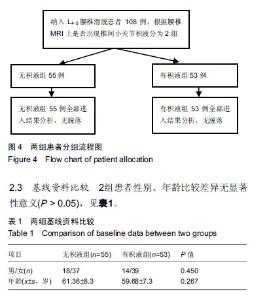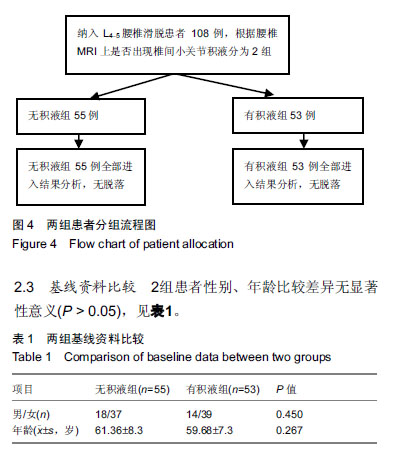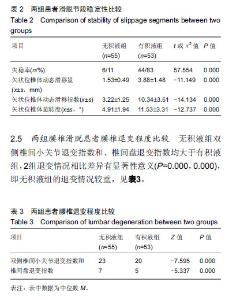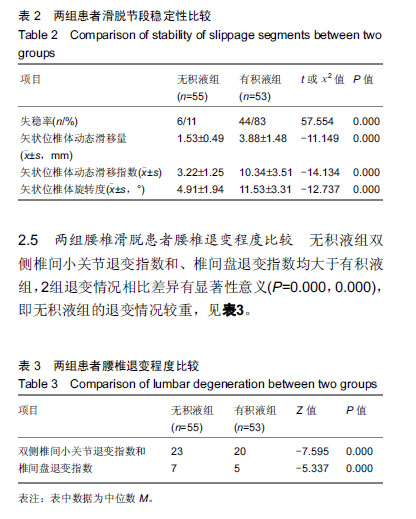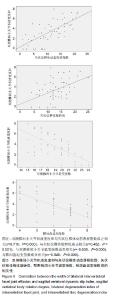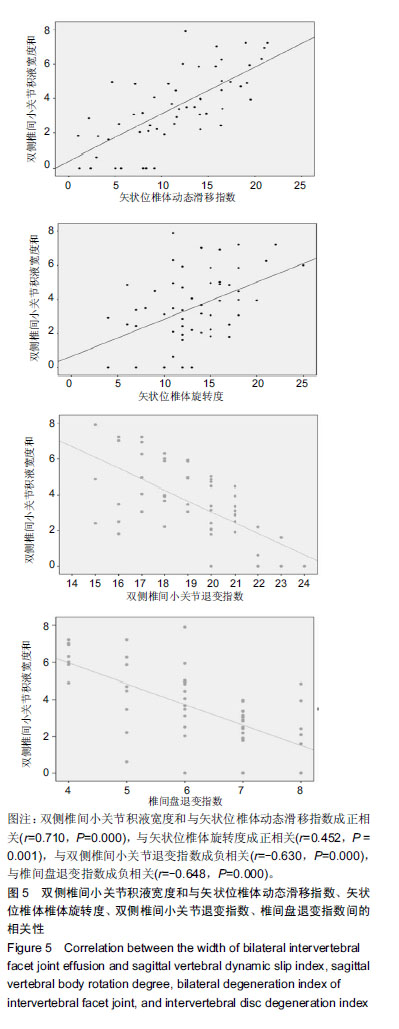| [1]Matz PG, Meagher RJ, Lamer T, et al. Guideline summary review: An evidence-based clinical guideline for the diagnosis and treatment of degenerative lumbar spondylolisthesis. Spine J. 2016;16(3):439-448.[2]王立侠,李龙鹏,李涛,等. 腰椎滑脱的X线诊断价值[J]. 中国医药导刊,2015,17(9):918-919.[3]沈剑粦,王宸. 退行性腰椎不稳诊断的研究进展[J]. 东南大学学报(医学版), 2013,32(1):118-121.[4]Hipp JA, Guyer RD, Zigler JE, et al. Development of a novel radiographic measure of lumbar instability and validation using the facet fluid sign. Int J Spine Surg. 2015;9:37.[5]Chaput C, Padon D, Rush J, et al. The significance of increased fluid signal on magnetic resonance imaging in lumbar facets in relationship to degenerative spondylolisthesis. Spine (Phila Pa 1976). 2007;32(17): 1883-1887.[6]任东风,侯树勋,吴文闻,等. MRI腰椎小关节积液影像对退行性腰椎动态不稳的预测价值[J].中国疼痛医学杂志, 2011,17(3): 131-133.[7]Steiger F, Becker HJ, Standaert CJ, et al. Surgery in lumbar degenerative spondylolisthesis: indications, outcomes and complications. A systematic review. Eur Spine J. 2014;23(5) : 945-973.[8]Grogan J, Nowicki BH, Schmidt TA, et al. Lumbar facet joint tropism does not accelerate degeneration of the facet joints. AJNR Am J Neuroradiol. 1997;18(7):1325-1329.[9]Griffith JF, Wang YX, Antonio GE, et al. Modified Pfirrmann grading system for lumbar intervertebral disc degeneration. Spine (Phila Pa 1976). 2007;32(24):E708-E712.[10]Boden SD, Wiesel SW. Lumbosacral segmental motion in normal individuals. Have we been measuring instability properly? Spine (Phila Pa 1976). 1990;15(6):571-576.[11]Denis F. The three column spine and its significance in the classification of acute thoracolumbar spinal injuries. Spine (Phila Pa 1976). 1983;8(8):817-831.[12]Alqarni AM, Schneiders AG, Hendrick PA. Clinical tests to diagnose lumbar segmental instability: a systematic review. J Orthop Sports Phys Ther. 2011;41(3):130-140.[13]Rihn JA, Lee JY, Khan M, et al. Does lumbar facet fluid detected on magnetic resonance imaging correlate with radiographic instability in patients with degenerative lumbar disease? Spine (Phila Pa 1976). 2007;32(14):1555-1560.[14]Cho BY, Murovic JA, Park J. Imaging correlation of the degree of degenerative L4-5 spondylolisthesis with the corresponding amount of facet fluid. J Neurosurg Spine. 2009;11(5):614-619.[15]刘大海,刘爽,牟建辉,等. 仰卧位MRI测量小关节积液对腰椎退变性滑脱稳定性诊断意义的研究[J]. 中国实验诊断学, 2015, 19(9):1564-1565.[16]Lattig F, Fekete TF, Kleinstuck FS, et al. Lumbar facet joint effusion on MRI as a sign of unstable degenerative spondylolisthesis: should it influence the treatment decision? J Spinal Disord Tech. 2015;8(3):95-100.[17]Fujii W, Kawahito Y, Nagahara H, et al. Monocarboxylate transporter 4, associated with the acidification of synovial fluid, is a novel therapeutic target for inflammatory arthritis. Arthritis Rheumatol. 2015;67(11):2888-2896.[18]Sellam J, Berenbaum F. The role of synovitis in pathophysiology and clinical symptoms of osteoarthritis. Nat Rev Rheumatol. 2010;6(11):625-635.[19]Kirkaldy-Willis WH, Farfan HF. Instability of the lumbar spine. Clin Orthop Relat Res 1982;165:110-123.[20]Vanhoenacker FM, Eyselbergs M, Cotten A. "Spinal degeneration: beyond degenerative disc disease": how to discriminate degeneration from spondylarthropathies? Neuroradiology. 2011;53 Suppl 1:S175-S179.[21]Videman T, Battie MC, Parent E, et al. Progression and determinants of quantitative magnetic resonance imaging measures of lumbar disc degeneration: a five-year follow-up of adult male monozygotic twins. Spine (Phila Pa 1976). 2008;33(13):1484-1490.[22]Cheng X, Zhang K, Sun X, et al. Clinical and radiographic outcomes of bilateral decompression via a unilateral approach with transforaminal lumbar interbody fusion for degenerative lumbar spondylolisthesis with stenosis. Spine J. 2017;17(8):1127-1133.[23]李显博,常恒瑞,王立飞,等. 单纯减压与减压融合内固定治疗退变性腰椎滑脱的荟萃分析[J]. 中国矫形外科杂志, 2018,26(17): 1585-1591.[24]Blumenthal C, Curran J, Benzel EC, et al. Radiographic predictors of delayed instability following decompression without fusion for degenerative grade I lumbar spondylolisthesis. J Neurosurg Spine. 2013;18(4):340-346.[25]Ghogawala Z, Dziura J, Butler WE, et al. Laminectomy plus fusion versus laminectomy alone for lumbar spondylolisthesis. New Eng J Med. 2016;374(15):1424-1434.[26]Mummaneni PV, Bisson EF, Kerezoudis P, et al. Minimally invasive versus open fusion for Grade I degenerative lumbar spondylolisthesis: analysis of the Quality Outcomes Database. Neurosurg Focus. 2017;43(2):E11. |
